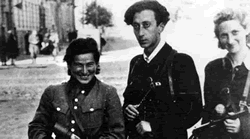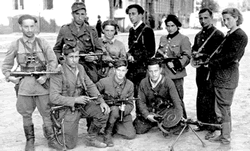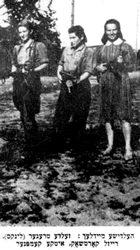Vitka Kempner Kovner, Vilna Partisan, Dies
(1920- 2012)
Credited With First Act of Sabotage Against Nazis in Ghetto

Faces of Resistance: Vitka Kempner Kovner, right, was credited with the first act of resistance against the Nazis in the Vilna ghetto. She is shown with fellow partisans Rozka Korczak, left, and Abba Kovner, center.
By Itzik Gottesman
Published February 16, 2012, (Forward) issue of February 24, 2012.
The legendary Vilna partisan Vitka Kempner Kovner died on February 15.
Widow of the poet and partisan leader Abba Kovner, she was born in the Polish town of Kalisz in 1920 and escaped from there to Vilna when the Germans invaded Poland.
Vitka Kovner was among the founding members of Abba Kovner‘s partisan organization, the FPO (United Partisan Organization) when it was organized in the Vilna ghetto in January 1942.
Her act of sabotage act, blowing up a Nazi train, was the first carried out by the FPO organization and possibly the first act of resistance by any woman against the Nazis in Eastern Europe.
Hirsh Glik‘s Yiddish song Shtil di nakht iz oysgeshternt(The silent night is full of stars) described her act of resistance. In 1946 she and Abba Kovner came to Palestine and settled in the kibbutz Ein Hakhoresh where they raised two children.
Read more: http://www.forward.com/articles/151582/#ixzz1mvvniWD5
World War II partisan Vitka Kovner dies at 92
By JEREMY SHARON02/17/2012 03:29
Vitka Kovner participated in sabotage operations against German forces along with her husband and other Jewish partisans.By Yad Vashem Archives Vitka Kovner, a Jewish partisan fighter during the Second World War, passed away on Wednesday at her home on Kibbutz Ein Hahoresh. She was 92 years old.
Kovner, who grew up in Kalisz, Poland, was the widow of poet and partisan Abba Kovner, and participated in operations against German military targets with the United Partisan Organization (FPO – Fareynigte Partizaner Organizatsye in Yiddish), which was formed in January 1942.
“Vitka Kovner’s story is one of struggle, courage and determination, not only to survive but to triumph, not only to save her own life, but to be with the Jewish people during its most difficult hours, even when that meant that her own life would continue to be threatened by the Nazis,” Yad Vashem chairman Avner Shalev said in a statement issued by the Holocaust Museum following her death.
Following the German invasion of Poland in 1939, Kovner fled to Vilna, then part of Soviet- occupied Poland and still a free city. After the German occupation of Vilna in June 1941, Kovner and other partisans from the FPO smuggled weapons through the sewer system and participated in sabotage operations against German forces.
“I joined the team that was responsible for attacks outside the [Vilna] ghetto, and my first and important mission, together with Yoske Maskovitz, was to detonate a bomb on the railway in order to damage the train that transported equipment to the front,” Kovner told the Yad Vashem quarterly magazine in 2001.
Vitka was awarded a Soviet medal of valor for her participation in the bombing of the German train.
Following the liquidation of the Vilna ghetto in September 1943 and a failed uprising, Kovner and other partisans escaped to the Rodniki Forest 40 kilometers south of Vilna where they conducted raids and ambushes against German forces, commanded by Abba Kovner. FPO partisans also participated in the liberation of Vilna by the Soviet army and the Armia Krajowain Polish resistance movement in July 1944.
Between 20,000- 30,000 Jews formed or joined organized resistance groups, according to the Jewish Partisan Educational Foundation in San Francisco.
Vitka arrived in mandatory Palestine in 1946, and settled on Kibbutz Ein Hahoresh where she married Abba Kovner. She was buried on the Kibbutz on Thursday and is survived by children and grandchildren.
VITKA KEMPNER-KOVNER
Full image
Women played an unusually prominent role in the Jewish underground in German-occupied Eastern Europe. Pictured here are three of the important leaders of the resistance in the Vilna Ghetto (L to R): Zelda Nisanilevich Treger, Rozka Korczak-Marla and Vitka Kempner-Kovner.
Institution: Yad Vashem, Jerusalem
by Neima Barzel
Vitka Kempner was born on March 14, 1920 in the county-town of Kalisz (Kalisch), western Poland, one-third of whose population was Jewish. Her parents, Hayyah and Zevi, ran a retail business. Her large tribe of grandparents, uncles and cousins were liberal both in outlook and in lifestyle. At home they spoke Polish, not Yiddish. Kempner, who studied at a progressive Jewish school, was independent from her early years, working for her living even at a young age. The first woman to join the Revisionist youth movement Betar, she took pride in belonging to a militarist group. Only in the twelfth grade did her friends convince her to transfer to Ha-Shomer ha-Za’ir. Upon the completion of her studies in the gymnasium, she moved to Warsaw, where she studied in a seminary for Jewish studies. As a student, she joinedAvukah, a student movement affiliated with Ha-Shomer ha-Za’ir, and was active mainly in the intellectual sphere. Proud of both her Jewish and her Polish identity, she did not find belonging to an elitist group at all problematic.
At the time of the German invasion of Poland in September 1939, Kempner was staying in Kalisz. Once she witnessed the brutality of the SS and their abuse of Jews, she determined that she would “not be humiliated.” She left her parents and escaped to Vilna together with her younger brother Baruch (b. 1923) (whom their grandfather had brought back from Lodz), and many other Jewish youngsters. Vilna, which was then a free city, served as a gathering place for the members of the Zionist youth movements who were searching for routes of immigration to the Palestine. The occupation of Vilna by the Soviets in June 1940 led to ideological arguments among the members of Ha-Shomer ha-Za’ir on the issue of identification with the USSR. Finally, the youngsters went underground and, adhering to the principles of cooperation, made their living by work in fields and in factories.
Persecution of Jews began soon after the German occupation of Vilna on June 24, 1941. At a time of arrests and the mass murder in Ponary, the intrepid Kempner became an important figure, transferring movement members to hiding places. Abba Kovner (1918–1988), Arie Wilner (1917–1943) and other members hid in a convent. In the course of the mass murders, the Germans erected two ghettos in Vilna. The population of Ghetto No. 2 was destined for extermination. Kempner and Rozka Korczak, lacking the papers that would allow them to live in the ghetto, had to hide. A heated argument was held among the members of the Halutz movement as to whether to stay in the ghetto or attempt to save the members of the movement by finding a safer place. Abba Kovner, Haika Grosman, Kempner, Rozka Korczak and others decided to remain in the ghetto, sustain the movement and make arrangements for armed resistance. The turning point occurred on the night of December 31, 1941, when Abba Kovner read aloud his manifesto of the uprising: “Let us not go like sheep to the slaughter.” Possessing forged papers, Kempner was active for a while as a coordinator, but requested permission to return to the ghetto: “I begged to be allowed to return to the ghetto … notwithstanding the risks, you are part of a group … you are among people who share a common fate.” At the same time, she insisted upon occasional participation in partisan missions.
On January 21, 1942, the United Partisan Organization (Fareynigte Partizaner Organizatsye, FPO), was established. It was the only organization in the ghettos that included all the Zionist youth movements. According to Kempner, the organization was directed towards a single goal—armed resistance. “To do things other than those related to the FPO was unacceptable, to say the least. It was considered high treason. How could one be involved in a life of culture when the world was on the verge of destruction and Jews were going to die?” Kempner was the one who carried out the first act of sabotage against Germans. For a long time she patrolled and investigated the time-table of German military trains that reached Vilna—activity which involved mortal danger. Together with a partner, Itzke Matzkevich (d. 1943), she carried the explosives and hid them on the railroad track. Since the “Partizamka” (Partisan organization) did not yet exist in the forests in 1942, the Germans did not suspect that it might have been Jews who had blown up the train.
The major crisis in the underground took place in July 1943, when it became clear that the remaining Jews in the ghetto supported the surrender of the FPO commander, Yitzhak Wittenberg (1907–1943), to the Germans. Kempner painfully recalls the situation in which the youngsters, who assumed they had won the ghetto population over to rebellion, were in fact rejected by the Jews and regarded as the ones who jeopardized the ghetto’s existence. Kempner explained their decision to stay in the ghetto despite their exclusion: “We never thought in terms of rescue and living, but about a response adequate for Jews at that time.”
The final liquidation of the Vilna Ghetto and the deportation of the remaining Jews to Estonia occurred on September 23 and 24, 1943. Kempner was the one who moved regularly between the ghetto and the outside world through the sewage canals, leading underground groups and carrying ammunition to the meeting points outside the city, from which the groups departed to the forests. She led the last group of sixty fighters, including Abba Kovner, to the forests of Rodninkai. In the Jewish partisans’ camp, Kempner became the commander of the patrol group in charge of collecting information, maintaining contact with the underground in the city, transferring medications, leading units on combat missions and performing acts of sabotage.
In addition, she guided groups of Jewish fighters to the forest until the Jewish camp numbered six hundred. The life of utmost poverty in the thick forest, in swampland, in an underground bunker was conducted with severe military rigor. The personal relationship between herself and Abba Kovner began at this time. The Jewish women, Kempner attests, were brave and determined in the execution of combat missions. She herself never took a thing from the farmers for her own benefit. “The comrades used to laugh at me and say that I was not a human being—you don’t need sleep or food and you don’t understand how a human being lives.” In July 1944, she was the first to reach liberated Vilna as the commander of a patrol unit, meeting Jewish Soviet soldiers for the first time, amidst great excitement and weeping. Kempner was awarded the highest badge of courage in the USSR.
Immediately after their arrival in Vilna, Abba Kovner, Rozka Korzhak and Kempner decided to find the surviving members of Ha-Shomer ha-Za’ir and promote immigration to Palestine. In January 1945, survivors from the youth movements, the partisans, and those returning from the USSR gathered in Lublin, where the temporary government of Poland had been established. Here they founded the Organization of Eastern European Survivors, headed by Abba Kovner, which aimed to promote the exodus of Jews from Eastern Europe. Kempner, who shared Kovner’s conviction that after the Holocaust there was no justification for the renewal of Jewish life in Europe, engaged in the smuggling of refugees across the border to Romania. Kovner also formed a secret “revenge” unit whose goal was to carry out revenge operations in Europe against persons who had committed murders or had been responsible for them. In July 1945, his unit reached Italy, where they were met with great enthusiasm by the Jewish Brigade , a British army unit, most of whose members were Palestinian Jews. Determined to devote themselves to revenge, the unit continued the war-time life of the underground. For them, World War II had apparently not come to an end. In their opinion, says Kempner, revenge should not be based upon the idea of terror, but be conceived as an essential public act, meant to execute historical justice upon the murderers.
Kovner left Italy in August 1945 and sailed for Palestine to obtain the material he needed for the planned revenge operations. On his return journey he was arrested by the British and imprisoned in Egypt. In February 1946 he was transferred to a prison in Jerusalem and released in April 1946. Meanwhile Kempner and the unit remained in Europe. The long months of plotting and involvement with the plan for revenge during 1945–1946, the problems involved in execution of the plans, the failures, and the opposition encountered from the Yishuv leadership, left the unit with a feeling of bitterness and a sense of betrayal. Finally, the Haganah leaders in Europe persuaded the unit to leave Europe for Palestine.
When Kempner and the group arrived in Palestine in July 1946, Kovner and Rozka Korczak met them and convinced them to go to Kibbutz Ein ha-Horesh. There they were met with excitement, the kibbutz members vacating their rooms for the partisans in order to enable them to rest and recuperate.
The group engaged in heated arguments about proceeding with revenge operations. Kempner was among those who contended that it was time to end the war and start a new life. She worked in the fields and this hard work “open land, peace, fresh air and the fields” brought her back to life, despite her weakness and weight-loss.
At Ein ha-Horesh Kempner and Kovner decided to formalize their relationship and start a family. Michael, their first son, was born on May 27, 1948 in the midst of the War of Independence (November 30, 1947–July 20, 1949) while Kovner was serving on the southern front. When Michael was three, Kempner contracted tuberculosis. The manner in which she coped with the disease, the enforced separation from her young son and from her kibbutz home were marked by her usual determination. She decided not to be addicted to suffering and took up university studies by correspondence: history, English and French. The year she spent in hospital strengthened her awareness of the unique kibbutz togetherness. Despite the contagious nature of the disease, the kibbutz members were not afraid to visit her. Compelled to stay at home for an additional year, she could see Michael only from a distance—circumstances that caused her enormous pain. When she recovered, her doctors forbade her to bear children, and when she became pregnant and gave birth to Shlomit in 1956, the baby’s upbringing was accompanied by numerous prohibitions— “I was not allowed to kiss her, and could hardly touch her”—which increased her agony.
The determination to resume ordinary life was accompanied by a decision to engage in useful and interesting matters. Kempner was unable to adapt to the routine activities of the women kibbutz members, engaged in the sewing-room and kitchen. At her own initiative, she began helping children with their studies, eventually turning to the field of special education. At the age of forty-five, she decided to study clinical psychology as a full academic discipline. Bar Ilan University granted her permission to complete her studies for the first and second degrees in only three years. During her studies, inspired by Dr. George Stern, a lecturer in Psychology at Bar Ilan University, she developed a new form of therapy, “Non-verbal therapy by color,” which was implemented with great success in the Unit for Parent-Child Treatment at the Oranim Teachers’ College of the Kibbutz Movement. At the same time, she continued to help children at Ein ha-Horesh by tutoring, counseling and treatment, which was rare on the kibbutz. In time, she began instructing psychologists who wished to follow her therapeutic methods.
During all these years, the creative and energetic Kempner was above all the wife of Abba Kovner, poet, leader, philosopher and visionary. She accompanied his literary work and his rich and turbulent public life, while her kibbutz home served as a meeting place for artists, public figures and politicians. Here Kovner played the leading role, with Kempner in the shadows. Through Kovner she met the “great people,” she said. But she absorbed true eminence from Dr. Stern, and her work provided satisfaction and ongoing intellectual challenge. Kempner longed for the cultural milieu of the big city and found ways of fulfilling her need for theater and concerts. When Kovner fell ill with cancer in the summer of 1985, she accompanied him on the arduous road of medical treatments, standing by him when he had surgery in the United States and could no longer speak. Only after Kovner’s death in 1988 and Rozka Korczak’s passing in 1988 did her unique personality come to public light. Only then did people recognize her tremendous heroism in the days of the partisans and acknowledge her struggle to shape a meaningful, unique and worthwhile life of her own. Today Kempner still works as a psychologist on her kibbutz; she describes herself not as a survivor but only as strong. “I lived life fully, actively, without dragging grievances and offenses behind me.”

